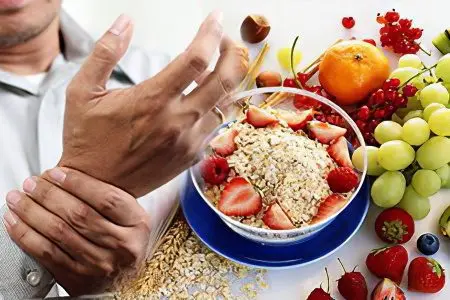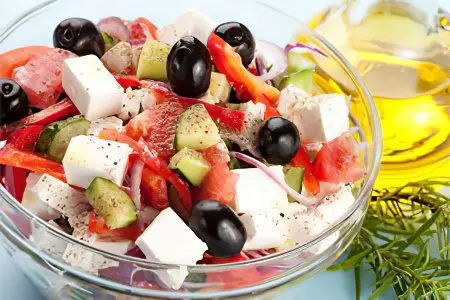Contents

For those who are familiar with rheumatoid arthritis, there is no need to talk about excruciating joint pains, bouts of morning weakness, and hands twisted by disease.
Rheumatoid arthritis is an autoimmune disease, accompanied by a change in appearance, habits, and even character. It has the character of a hereditary predisposition, but can also be provoked by the systematic use of certain substances in adverse conditions.
The disease is chronic and, after visible periods of relief, an exacerbation can begin at any time. Therefore, the presence of the disease leaves an imprint on the habits and lifestyle of a person for the rest of his life.
To achieve effective results, a combination approach is needed: following the doctor’s prescriptions for drug treatment, exercise and nutrition with special diets for rheumatoid arthritis.
Traditional treatment
Medical treatment with steroids and anti-inflammatory drugs is aimed at achieving the following results:
removal of temperature;
relief of pain;
elimination of physical weakness;
fight against asthenia.
Since the disease is almost always accompanied by asthenia, the food should be as nutritious as possible and, at the same time, contain only those substances that contribute to the healing of the connective tissue of the joints.
You can not be treated according to the recipes of your friend, suffering from the same disease. Some medicines have side effects. Non-steroidal anti-inflammatory drugs can cause stomach ulcers or high blood pressure. Only a doctor can decide which medicine is right for your body.
Treatment prescribed by a doctor, physical procedures and a healthy diet are the only sources of real health.
These procedures can be supplemented with alternative types of treatment: compresses, lotions and ointments based on folk recipes.
The role of nutrition in treatment

Weakened immunity requires a sufficient amount of vitamins to normalize its condition. The usual diet and diet periods should be filled with meals containing niacid, ascorbic acid and bioflavonoids.
Vitamin C stabilizes the hormonal background, strengthens the walls of blood vessels, increases anti-hyaluronidase activity. Bioflavonoids help reduce the permeability of vessel walls. Niacin strengthens the circulatory system and helps the stomach work.
Included in the diet: lemons, apples, rose hips, bell peppers, black currants and other available berries, vegetables and fruits can significantly improve the functioning of the whole body and help it fight arthritis.
The basic principles of diet
Dietary change is a measure that is clearly necessary for people undergoing complex treatment for rheumatoid arthritis. The purpose of special nutrition is to replenish the nutrients necessary to resist the disease and to exclude foods that are not absorbed by the body and cause an exacerbation.
So, you need to exclude the withdrawal of calcium from the body – give up coffee, cocoa and chocolate, spinach, sorrel, rhubarb. Salt is also one of the most active elements that remove calcium.
To enrich the body with magnesium, which is especially necessary during an exacerbation, it is necessary to include cereals in the diet, except for oatmeal, wheat, corn and some types of legumes.
Eliminate at least for the duration of the diet:
Fatty dairy products;
Fat meat;
Sugar, jam, honey;
Nuts;
Alcohol;
Tomatoes, potatoes and eggplants are sources of solanine;
Citrus;
Salt (or cut your salt intake in half).
During the increase in pain, it is necessary to switch to a strict diet.
Diet during an exacerbation

Breakfast (option 1): Omelet from 2 eggs, unsalted buckwheat porridge, tea.
Breakfast (option 2): Buckwheat porridge, soft-boiled egg, unsweetened baked apple, tea;
Lunch (option 1): Vegetable soup, boiled beef with vermicelli, compote;
Lunch (option 2): Vegetarian borscht, boiled fish with rice, compote;
Dinner (option 1): Boiled fish with boiled potatoes, tea with lemon;
Dinner (option 2): Carrot – beef meatballs steamed with vermicelli, tea.
Bread and sugar in the active phase are excluded, food is cooked without salt, slightly salted just before consumption.
According to the diagram below, you can create a menu for periods without exacerbation for each day, based on your own habits and preferences. Then the diet will not seem forced, you will accept it with pleasure and, perhaps, make it a habit for life.
High Protein Diet
Breakfast (option 1): buckwheat porridge, scrambled eggs from 2 eggs or a soft-boiled egg, barley coffee;
Breakfast (option 2): cottage cheese casserole or cheesecakes, 1-2 soft-boiled eggs, barley coffee with a small amount of milk;
Lunch (option 1): beef meatballs or steam cutlets with rice or buckwheat porridge, fish soup, dried fruit compote;
Lunch (option 2): borsch on beef broth, boiled fish with rice, tea with lemon;
Dinner (option 1): cauliflower and chicken breast – stewed with a small amount of oil or boiled, compote;
Dinner (option 2): buckwheat porridge with boiled beef goulash, tea with lemon.
You can compose and vary the elements of such a diet in various combinations. Each meal contains the ideal amount of calories and nutrients. The main conditions are low-fat meat and fish, low-fat milk, a large amount of greens, a minimum of oil, salt, and a preference for boiled and steamed food.
In between meals, it is useful to drink decoctions of berries and rose hips, and eat baked apples as a healthy treat. At night, a glass of low-fat kefir or yogurt is allowed.
Such a diet contains the simplest products and is adapted for use in Central Russia. Vitamins and microelements obtained from this diet fully satisfy the needs of the body, depleted by the disease.









